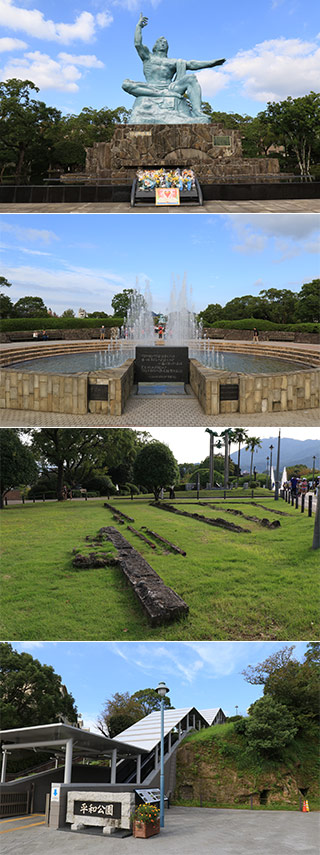74,000 people killed by the explosion and 150,000 killed in total.
Site of the Former Urakami Branch of Nagasaki Prison
The Urakami Branch of Nagasaki Prison was built on a site of 20,000 square meters, with its offices covering 13,000 square meters. It was located between 100m and 350m north of the hypocenter of the atomic bomb, and was the closest public building to hte hypocenter.
At 11:02 a.m. on August 9, 1945, the explosion of the plutonium bomb killed 18 staff, 35 facility residents and 81 inmates at the prison. in total 134 people died here. the wall surrounding the prison was 4m high, 0.25m thick and made from steel-reinforced concrete; it was reduced almost to its foundations. The wooden office buildings and kitchen were blown apart and burned down completely, save for a single remaining chimnery.
Air-daid Shelters in Matsuyama-machi
After the explosion, many public and privated cave-type air-raid shelters were constructed in hillsides in the vicinity of Peace Park, the location of the Urakami Branch of Nagasaki Prison. Although most people within 500m of ground zero were killed instantly by the atomic bomb, many othe people barely survived inside the shelters. However, most people who were exposed to the A-bombing sustained serious injuries due to fire and radiation, and died in agony one after another, not able to received any treatment in the shelter they evacuated to.
After the end of the war, the damage done by the atomic bombing to the shelters located near ground zero was investigated by the U.S. military, which recorded in detail the internal configuration of the shelters and the positions where survivors and the dead were found. The survey's findings are said to have been used as a reference in constructing other nuclear shelters in preparation for nuclear wars after WWII.
According to a survey conducted in 2009 by the Ministry of Land, Infrastructure, Transport and Tourism, there were 193 air-raid shelters in Nagasaki during the war. Located very close to ground zero, shelters in Peace Park and Matsuyama-machi are valuable as remaining structures that convey the importance of peace, the power of the atomic bomb and the horrors of war, including how people lived before, during and after the A-bomb was dropped.






